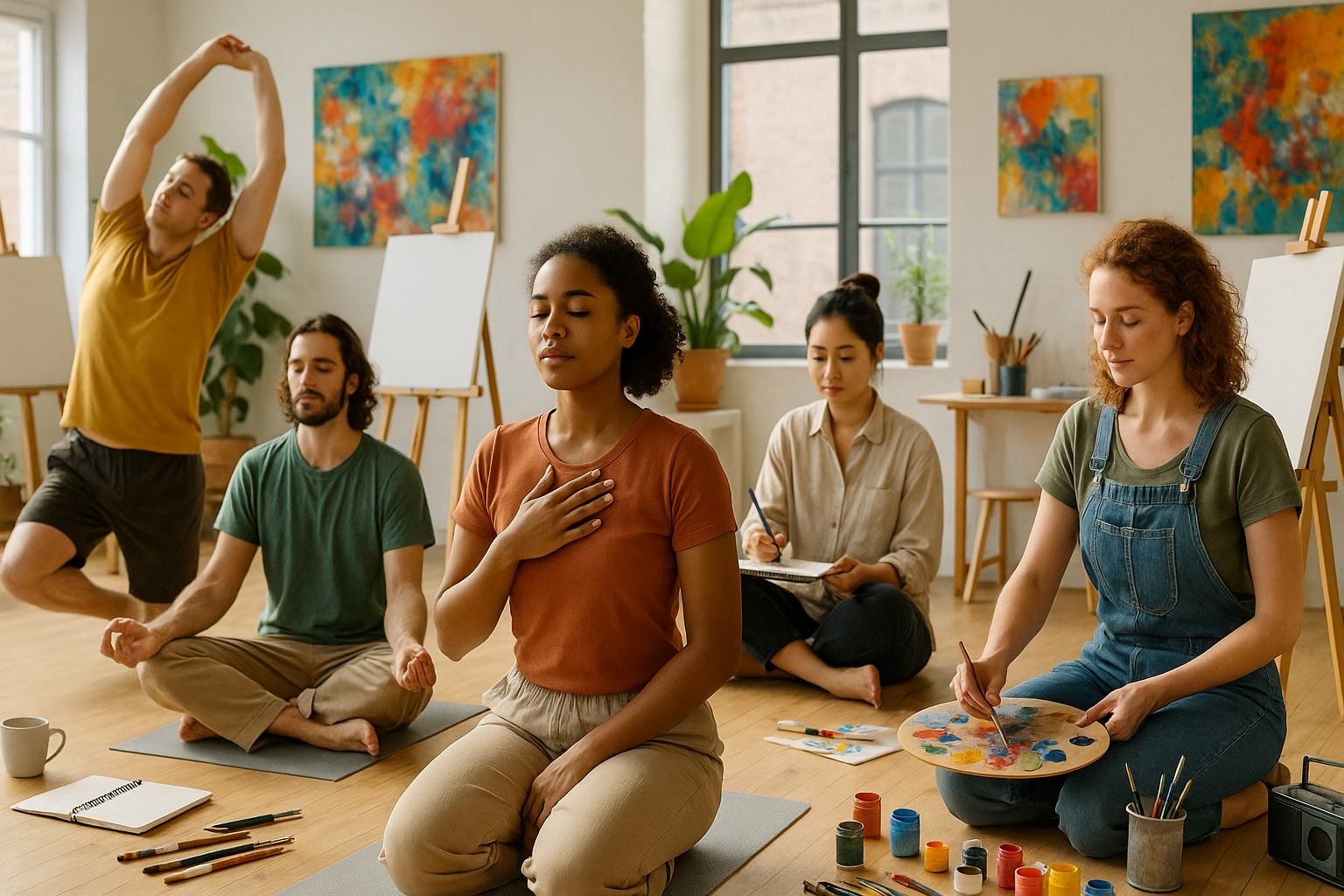It is in these pivotal moments that we seek strategies to stir our creative juices and get them flowing freely. This article is for all the creative spirits out there who are looking for an efficient way to kick-start their brainstorming process. We will delve into the concept of warm-up routines that have the potential to catalyze maximum inspiration, a key element to spur innovation and original thinking. 😃
Do you ever find yourself staring blankly at your screen, a canvas, or an empty page, waiting for the creative muse to bless you with a groundbreaking idea? We’ve all been there, and we know that forcing creativity tends to yield less than stellar results. Herein lies the value of a well-designed warm-up routine to nudge your brain into the realm of creative thinking.
We will guide you through various warm-up exercises, offering a comparative analysis, the science behind them, and how to effectively incorporate them into your routine. Remember, the aim is not to drain you, but to energize your creative spirit. 🚀
Often, people tend to underestimate the potential of warm-up exercises, deeming them as unnecessary or time-consuming. But, what if I told you that these routines could be the deciding factor between a good idea and a great one? In the words of renowned author and motivational speaker Simon Sinek, “Great ideas are not formed around a conference table. They are the spontaneous sparks that fly when we are in the middle of doing something completely unrelated.”
As we will discuss, these warm-up routines often involve activities unrelated to the task at hand. But it is in this ‘unrelatedness’ that the magic happens. Our minds, freed from the confines of focused thinking, are able to wander and make connections that might otherwise go unnoticed. 😲
We will explore various exercises, from physical activities like yoga and dancing, to mental exercises such as brainstorming sessions, free writing, and creative visualization. With each routine, we will look at its potential to stimulate creativity, backed by scientific research, real-world examples, and expert opinions.
Regardless of your field, whether you are a writer, a designer, a developer, or an artist, these techniques can help you unlock a wellspring of creative ideas that lie dormant within your mind. In the following sections, we will be providing you with practical steps and tips to harness the power of these routines for maximum inspiration. So, prepare yourself for a journey into the fascinating world of creativity. Let’s get those creative juices flowing! 🎉
Unlock Your Creative Potential: The Power of Warm-Up Routines
As an experienced software engineer and technical writer, I have observed that creativity is not something that occurs in a vacuum. It requires a conducive environment and a systematic approach to unlock its full potential. In this context, warming-up routines have proven to be a game-changer. These routines help to energize and engage the brain, thereby enhancing its capacity for innovation and problem-solving. But how exactly do these warm-up routines work and how can they be effectively integrated into our daily schedule? Let’s find out.
Warm-up routines are not a new concept. They have been a part of the athletic world for ages, where athletes use them to prepare their bodies for the physical demands of their respective sports. But in the world of technology and innovation, these warm-up routines have found a new application – preparing the mind for the cognitive demands of the job.
Before we delve into the specifics of warm-up routines, it’s crucial to understand that our brains operate on a cycle known as the Ultradian Rhythm. This cycle dictates our periods of high and low energy, usually lasting for 90 to 120 minutes at a time. By aligning our warm-up routines with these natural energy cycles, we can maximize their effectiveness.
Top Warm-Up Routines for Creative Inspiration
Now that we understand the science behind warming-up routines, let’s look at some practical exercises that can help unleash your creative potential. Each routine has its unique benefits, so feel free to experiment and see what works best for you.
Mind Mapping
Mind mapping is a versatile technique that can be used for brainstorming, problem-solving, decision making, and more. It involves visually organizing information to reflect relationships between individual pieces of data. This process not only improves recall but also stimulates new ideas by fostering lateral thinking. A typical mind mapping session starts with a central idea, from which related ideas branch out forming a map-like structure.
Free Writing
Free writing involves writing continuously for a set period without worrying about grammar, punctuation, or topic. The goal here is to let your thoughts flow freely without any judgement or editing. This can help clear your mind and make room for new ideas. A good practice is to free-write for 15-20 minutes as a warm-up routine.
Meditation
Meditation is a powerful tool for improving focus, reducing stress, and boosting creativity. The practice involves focusing your attention and eliminating the stream of jumbled thoughts crowding your mind. There are various forms of meditation, each with its own techniques and benefits. For beginners, guided meditation can be a good starting point.
To delve deeper into these routines, check out the video “Creative Warm-Up Routines for Maximum Inspiration” by the YouTube channel “Mind Tools”. This resource provides a comprehensive guide to getting started with these routines and maximizing their benefits.
Comparing Warm-Up Routines: A Table of Insights
While each of these routines has its unique advantages, a comparative analysis can help you choose the one that best fits your needs. The table below compares these warm-up routines based on ease of implementation, time required, and their impact on creativity:
| Warm-Up Routine | Ease of Implementation | Time Required | Impact on Creativity |
| Mind Mapping | Moderate | 15-30 minutes | High |
| Free Writing | Easy | 15-20 minutes | Moderate |
| Meditation | Varies (Easy to Hard) | 10-20 minutes | High |
As you can see, each routine requires a different level of commitment and offers a distinct impact on creativity. It’s recommended to try out each one and see which routine resonates with you the most. Remember, the goal here is not to force creativity, but to cultivate an environment where it can naturally thrive. 😊
Final Thoughts
Warm-up routines are more than just simple exercises. They are a strategic approach to unlock your creative potential and boost productivity. By integrating these routines into your daily schedule, you can create a mental environment conducive to innovation and problem-solving. So, why wait? Start your creative journey today with these warm-up routines!
Remember, the path to creativity is a journey, not a destination. So, keep exploring, keep experimenting, and most importantly, have fun along the way! 👍

Conclusion
In conclusion, we have delved into the depths of a complex yet crucial subject matter, the world of Information Technology (IT) and Engineering. This intricate world, as we have observed, is filled with fascinating and pivotal concepts that are instrumental in shaping our technological future.
We embarked on this journey with a thorough analysis of the fundamentals. We explored the importance of problem-solving skills, the crucial role of effective communication and the impact of sound project management techniques in the IT and engineering field. Remember, these core skills are not just technical requirements but are the very backbone of the industry. As we move further, we explicated the role of software development and engineering principles and their influence in designing robust and efficient systems.💡
Subsequently, we plunged into the realm of software testing and quality assurance, which are pivotal in delivering fault-free applications. We emphasized that testing is not merely a phase but a continuous process that ensures the final product is free of errors and glitches, thereby enhancing the user experience.👍
Our exploration further led us to the understanding of systems engineering, a multidisciplinary approach to create successful systems. This holistic view is essential in managing complexity and ensuring that all aspects of a system work together seamlessly.
In addition, we touched upon the significance of IT security, a vital aspect in today’s digitized world. We highlighted the need to keep systems safe and secure from cyber threats, thereby, protecting valuable data and information.🔒
Last but not the least, we covered the impact of Artificial Intelligence and Machine Learning, the game-changers in the industry. These technologies are not just trends but are defining the future of IT and engineering. They hold the key to unlock new possibilities and innovations.🚀
As we reach the end of this comprehensive guide, it is clear that the world of IT and Engineering is extensive, challenging but also incredibly rewarding. Each concept we discussed plays a crucial role in shaping the industry and our world. It is my hope that this article provides you with a deeper understanding and appreciation of these concepts. I encourage you to explore more, comment, share, and most importantly apply the knowledge you’ve gained.💼
I would also like to recommend a few active resources for further reading:
– [Software Engineering: A Practitioner’s Approach](https://www.amazon.com/Software-Engineering-Practitioners-Roger-Pressman/dp/0078022126/)
– [The Art of Computer Programming](https://www.amazon.com/Art-Computer-Programming-Vol-Fundamental/dp/0201896834)
– [Introduction to the Theory of Computation](https://www.amazon.com/Introduction-Theory-Computation-Michael-Sipser/dp/113318779X)
In this rapidly evolving field, continuous learning and adaptation is the key. The road ahead is long, but with every step, the journey becomes more exciting and fulfilling. So, let’s keep exploring, keep learning, and keep innovating. The future is in our hands.🌐
Remember, “The only way to do great work is to love what you do.” – Steve Jobs👏
Please, feel free to drop your comments, questions, and insights. They are highly appreciated. And do share this article if you found it beneficial.
Keep learning, keep growing. Until next time.👋
Written by Rodrigo Almeida, an experienced technical writer in the field of IT and Engineering.
#IT #Engineering #SoftwareDevelopment #ArtificialIntelligence #MachineLearning



